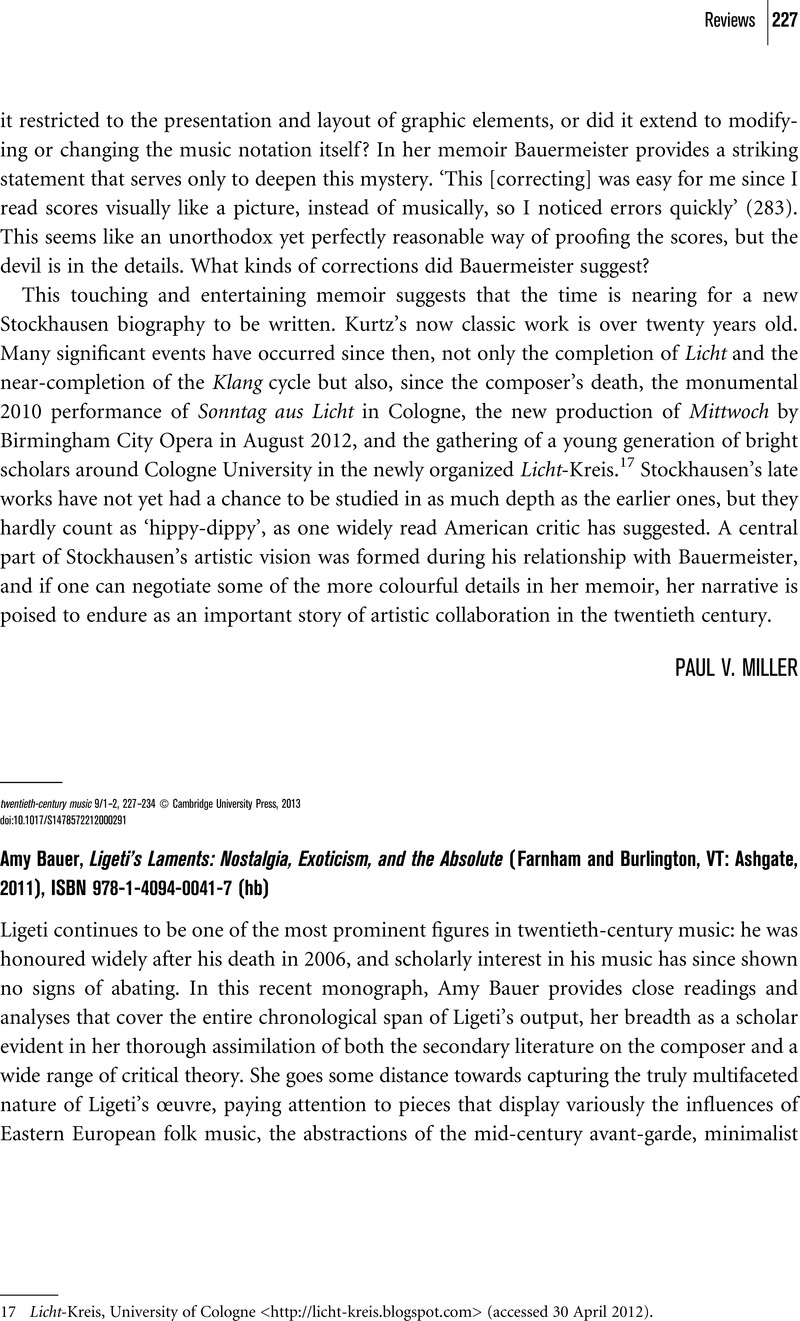Published online by Cambridge University Press: 27 March 2013

1 Jane Piper Clendinning coined the term ‘pattern-meccanico’ in her 1989 dissertation Contrapuntal Techniques in the Music of György Ligeti (Yale University, 1989). See also Clendinning, , ‘The Pattern-Meccanico Compositions of György Ligeti’, Perspectives of New Music 31/1 (1993), 192–234CrossRefGoogle Scholar.
2 This argument puts more ‘meat on the bones’ of Steinitz, Richard's hypothesis advanced some time ago in ‘Weeping and Wailing’, Musical Times 137 (August 1996), 17–22CrossRefGoogle Scholar.
3 See Dibelius, Ulrich, György Ligeti: eine Monographie in Essays (Mainz: Schott, 1994)Google Scholar; Floros, Constantin, György Ligeti: jenseits von Avantgarde und Postmoderne (Vienna: Lafite, 1996)Google Scholar; Lobanova, Marina, György Ligeti: Style, Ideas, Poetics, trans. Shuttleworth, Mark (Berlin: Ernst Kuhn, 2002)Google Scholar; Steinitz, Richard, György Ligeti: Music of the Imagination (London: Faber, 2003)Google Scholar; Toop, Richard, György Ligeti (London: Phaidon, 1999)Google Scholar.
4 Monelle, Raymond, The Sense of Music: Semiotic Essays (Princeton and Oxford: Princeton University Press, 2000), 15Google Scholar.
5 Monelle, The Sense of Music, 67–8.
6 Monelle, The Sense of Music, 17.
7 Monelle, The Sense of Music, 68.
8 Silbiger, Alexander, ‘Chaconne’, in The New Grove Dictionary of Music and Musicians, 2nd edn, ed. Sadie, Stanley and Tyrrell, John (London: Macmillan, 2001), vol. 5, pp. 410–15 (esp. 415)Google Scholar; online at Oxford Music Online <www.oxfordmusiconline.com> (accessed 28 June 2012).
9 Shepard tones use synthesized sine tones spaced at octaves to create the aural illusion of an ever-descending or ever-ascending continuous scale. One commentator has characterized it as an aural version of a barber's pole (see Mike Elliott, ‘Sound Design: Falling Forever (The Shepard Tone)’ <http://audio.tutsplus.com/tutorials/sound-design/sound-design-falling-forever-the-shepard-tone/>, accessed 27 June 2012). Shepard, Roger originally published his findings in the article ‘Circularity in Judgments of Relative Pitch’, Journal of the Acoustical Society of America 36 (1964), 2346–53CrossRefGoogle Scholar.
10 Stephen Taylor, ‘The Lamento Motif: Metamorphosis in Ligeti's Late Style’ (DMA diss., Cornell University, 1994); Taylor, , ‘Passacaglia and Lament in Ligeti's Recent Music’, Tijdschrift voor Muziektheorie 9/1 (2004), 1–22Google Scholar; John Cuciurean, ‘A Theory of Pitch, Rhythm, and Intertextual Allusion for the Late Music of György Ligeti’ (PhD diss., State University of New York, Buffalo, 2000), 155–61; Richard Steinitz, György Ligeti, 244–60; Willson, Rachel Beckles, Ligeti, Kurtág, and Hungarian Music during the Cold War (Cambridge: Cambridge University Press, 2007), 178–86Google Scholar; Metzer, David, Musical Modernism at the Turn of the Twenty-First Century (Cambridge: Cambridge University Press, 2009), 144–74Google Scholar; Searby, Michael D., Ligeti's Stylistic Crisis: Transformation in his Musical Style 1974–1985 (Lanham, MD: Scarecrow Press, 2010), 111–25Google Scholar.
11 Taylor, ‘Passacaglia and Lament’, 4.
12 In including this detail, Bauer seems to follow David Metzer, who provides evidence that the drone and the descending three-phrase lament melody both relate to Eastern European folk lament practices (Musical Modernism, 152–3). Rachel Beckles Willson transcribes a Romanian folk lament and suggests how it might relate to Ligeti's motive in the fourth movement of the Horn Trio (Ligeti, Kurtág, and Hungarian Music, 180–82). Bauer mentions in the next chapter that Ligeti cited Monteverdi's Lamento della ninfa and the ‘Crucifixus’ from Bach's B Minor Mass as ‘strong influences’ (175).
13 See Samson, Jim, ‘Genre’, in The New Grove Dictionary, 2nd edn, vol. 9, pp. 657–9Google Scholar; online at Oxford Music Online <www.oxfordmusiconline.com> (accessed 28 June 2012).
14 Dubrow, Heather, Genre (London and New York: Methuen, 1982), 2Google Scholar and (on the ‘generic contract’) 31–7. See also Monelle, The Sense of Music, 115–46, esp. 118–19.
15 Metzer, Musical Modernism, 145. As he writes, ‘Many composers since that time [c1980] have turned to the lament. The choice hardly comes as a surprise, for the genre pulsates with expressive effects and associations’ (144–5).
16 Porter, James, ‘Lament’, in The New Grove Dictionary, 2nd edn, vol. 14, pp. 181–8 (p. 181)Google Scholar; online at Oxford Music Online <www.oxfordmusiconline.com> (accessed 28 June 2012).
17 Wilson, Charles, ‘György Ligeti and the Rhetoric of Autonomy’, twentieth-century music 1/1 (2004), 5–28CrossRefGoogle Scholar; Marx, Wolfgang, ‘“Make Room for the Grand Macabre!” The Concept of Death in György Ligeti's Œuvre’, in György Ligeti: of Foreign Lands and Strange Sounds, ed. Duchesneau, Louise and Marx, Wolfgang (Woodbridge: Boydell Press, 2011), 71–86Google Scholar.